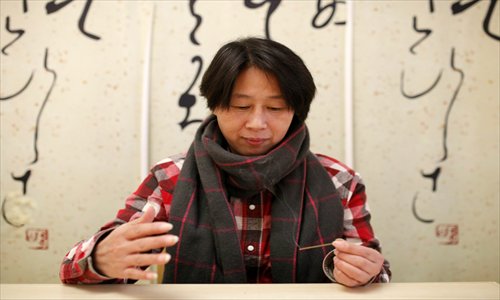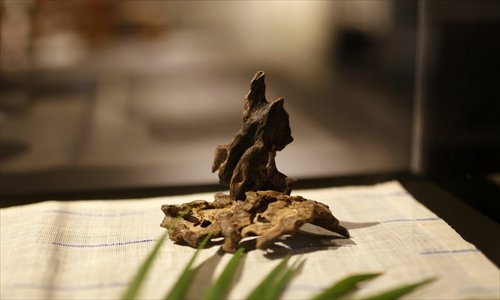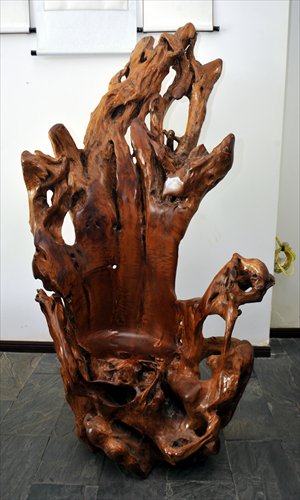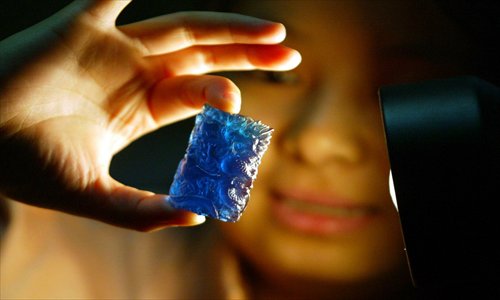The new treasure hunt

The Chinese tuhao, the nouveau riche, have been making headlines in China and abroad this year. Reports of tuhao and tuhao dama (rich greedy middle-aged women) crowding out luxury shops and fighting for gold ornaments in China and in cities around the world have become commonplace.
But there is another wave of Chinese who could buy LV, Prada or Hermès, gold and rare stones but look for something else. They want rare things that few others can own. These are the new breed of collectors who amass quiet piles of treasures with knowledge and an anticipation that these will accumulate wealth.
For most people a piece of agarwood (gingko or aloeswood) looks like any other piece of deadwood. But for Sun Guang'e, the curator of the Shanghai Jiahe Agarwood Culture Museum, who has been collecting and studying agarwood for 20 years, agarwood is not just a delicately scented wood but a cultural heritage.
Regarded as the "diamond of wood," good examples of agarwood at the international auction houses Sotheby's and Christie's fetch more than $10,000 a gram, 100 times the price of gold. Compared with art, jade and porcelain, agarwood is becoming a very popular collector's item for wealthy Chinese although the tuhao seem to miss out here. "Most tuhao wouldn't know about agarwood. They spend tens of millions of yuan on fake or poor-quality agarwood, which is a pity," Sun Guang'e said.
Origins are vital
Sun said that to distinguish good agarwood from low-quality stuff, a collector must first know where the agarwood comes from. Agarwood contains a resin generated from only a rare species of fungus-infected evergreen trees. These trees only grow in certain warm and wet areas. In Asia the tree species include aquilaria sinensis which is found in China's Hainan, Yunnan, Guizhou, Guangxi and Guangdong, along with aquilaria agallocha from Vietnam, Cambodia and Laos, and aquilaria crassna from Malaysia and Indonesia. The price for agarwood varies from hundreds of yuan to tens of thousands of yuan per gram depending on the quality of the example.
Agarwood is precious because of the way it is formed. Only a few specific species of trees are affected by the fungus which provokes the trees into producing the rich rare resin and oil that make agarwood so distinctive. It is also a lengthy process. In the aquilaria sinensis tree species it takes at least 30 years to produce the resin and high-quality resin will need another 20 years to develop.
Looking for and processing agarwood is painstaking. Sun Guang'e recalled a search for agarwood with farmers on Wuzhi Mountain in Hainan Province in 2007. It took her four hours on a motorbike to arrive at an area deep in a forest where agarwood might be found. They camped there for a month.

Hunting at night
Experts can only hunt for agarwood at night in the dark. When they smelt the aroma, the farmers marked the spot on the ground and returned in daylight to check their finds. The resin-bearing trees are often found in swamps which can make the search physically dangerous.
Then the process of removing the deadwood and exposing the resin-affected parts of the trees can take another six months.
The value of agarwood is dependent upon the aroma it produces. Top-quality agarwood should include six scents - fish, spicy, mint, sweet, herbaceous and bitter. "Agarwood aromas are used in traditional medicine to help heal people and also for pure pleasure," Sun said.
Agarwood was used in China 2,000 years ago but then it was a product fit for the royal court and only emperors, empresses and concubines could enjoy it. "Even in the Sui Dynasty (581-618) and the Tang Dynasty (618-907), the resin was regarded as very precious although aristocrats used it constantly, either in a powdered form or putting it in water to wash their faces. In the old days people measured tea and ordinary crops by what they called a dan which equaled 75 kilograms, gold was measured by the ton but agarwood was only measured by the liang which equaled 50 grams - which shows how rare it was even then," she said.
The earliest records of agarwood are found in Chinese medical writings. According to the Compendium of Materia Medica, or Bencao Gangmu (a book on Chinese herbal medicine compiled by Ming Dynasty (1368-1644) doctor Li Shizhen), the most important thing about agarwood was its many applications in medicine. "The six different scents of agarwood have different functions. The fish scent is good for the nerves, the spicy scent stimulates the mind, the herbal scent has an anesthetic effect, the sweet scent is good for the lungs, the mint is refreshing, and the bitter scent can reduce internal heat. These natural smells are completely different from the synthetic scents used in perfumes," Sun Guang'e said.
She has seen the positive effect of agarwood herself. A few years ago when Sun's mother was hospitalized with a serious heart complaint, Sun gave her some small pieces of agarwood. Her mother recovered but the women she shared a room with in the hospital and who were suffering from similar complaints died. Sun believes the agarwood saved her mother's life.
Because it is rare and extremely valuable some traders try to sell fake agarwood. Sun was given one piece of fake agarwood cleverly disguised as the real thing, imbedded in a piece of a genuine tree. She eventually burned a fragment and immediately smelt traces of asphalt which would not be detectable in the genuine article.

Plantations cultivated
Although agarwood plantations are being cultivated in Hainan Province, Sun does not think the quality of this agarwood is anywhere near the quality of the natural product. "Artificially grown agarwood is infected by a synthetic fungus, and the resin is cultivated and grown quickly. The scent and the quality cannot match the natural product."
The Chinese tuhao have also taken to buying elegant furniture and carvings made of wumu, black fossilized ebony. It achieves its unique density and colors from being buried underground for thousands of years.
While most trees buried for thousands of years become coal, a few turn into this rare type of wood that when polished becomes an ideal form for carving delicate and beautiful pieces of furniture or ornamentation.
Zhu Ping, the director of the Wood Science Research Center of the Shanghai Timber Trade Association, said wumu is wood at an early stage of silification where it could become, over thousands of years, a stonelike substance.
Because of its rarity and because it is now so expensive and hard to find, it made the headlines recently. In September, Liang Cai, a villager from Xiushui county in Jiangxi Province extracted a huge 80-ton block of wumu from a nearby river. He used an excavator and spent a great deal of time and money on the project mainly because he believed the wumu was worth millions of yuan.

Government claim
However under Chinese law, anything recovered from below ground belongs to the State unless the finder can prove that his forebears owned it legally. The local government immediately claimed the block of wumu and although scientific testing has not yet established exactly how much it could be worth, the action created a good deal of controversy.
Most recently the government has offered to compensate him 75,000 yuan ($12,356) for the expense he incurred in the extraction.
Of all the varieties of wumu, a type found mainly in Sichuan and produced from a laurel tree species is the most highly prized. Items made from this can fetch millions of yuan, a hundred times the cost of other types of wumu.
But not every collector knows what he or she is getting. "In the past, this laurel tree wumu was mostly used for making coffins because of its quality. Now investors and speculators are driving the price up even though there is still a great deal of this buried in Sichuan Province. And many tuhao collectors know little about this and less about what wumu is exactly. They buy carved ornaments that have been made from coffin wood and don't realize their origins," Zhu said.
In the 1960s, when Xu Guoxi, the antiques' connoisseur of the Art Identification Center at the Shanghai Federation of Literary and Art Circles, started to work in antiques and artworks, Chinese mila, a form of amber, was not valued as highly as amber. Mila is a yellow resin like amber, but is formed under different conditions and is not as transparent.
However, perhaps because of the cultural background, mila is becoming popular among collectors. Overseas it is often used to make jewelry but few foreigners collect it as such.
"Because nowadays Chinese calligraphy, jade, porcelain and other traditional antiques fetch high prices and there are fewer quality items, rich people have begun looking at mila. And obviously some crooks are now making fake mila items," said Xu.
Fakes prevalent
Other collectors are amassing rhinoceros horn. Xu said in the 1960s rhinoceros horn cost 96 yuan for 30 grams, a little more expensive than gold which was then 94 yuan for 30 grams. Today rhinoceros horn is priced at more than 100,000 yuan for 50 grams. Fakes are also prevalent here. "Some people have worked out a way of fashioning horses' hooves into rhino horns," Xu said.
He warned that although more wealthy Chinese have begun collecting rare items, not everyone can make a profit through collecting. Successful collectors need financial resources and courage - "You have to be confident with the money you spend collecting." They also need to be aware. "As the market expands there are more and more fakes being offered. People make money selling fake items because the buyers don't know enough about their collections." Finally a successful collector needs patience. "You can't make money by selling a collection soon after you have acquired it. You have to wait for the price to rise and it is not always easy to sell good items."